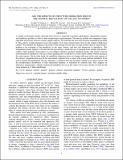| dc.contributor.author | Elkholy, Tamer Y. | |
| dc.contributor.author | Canizares, Claude R. | |
| dc.contributor.author | Bautz, Marshall W. | |
| dc.date.accessioned | 2015-09-03T17:32:48Z | |
| dc.date.available | 2015-09-03T17:32:48Z | |
| dc.date.issued | 2015-05 | |
| dc.date.submitted | 2014-07 | |
| dc.identifier.issn | 1538-4357 | |
| dc.identifier.issn | 0004-637X | |
| dc.identifier.uri | http://hdl.handle.net/1721.1/98356 | |
| dc.description.abstract | A sample of 46 nearby clusters observed with Chandra is analyzed to produce radial density, temperature, entropy, and metallicity profiles, as well as other morphological measurements. The entropy profiles are computed to larger radii than in previous Chandra cluster sample analyses. We find that the iron mass fraction measured in the inner 0.15R[subscript 500] shows a larger dispersion across the sample of low-mass clusters than it does for the sample of high-mass clusters. We interpret this finding as the result of the mixing of more halos in large clusters than in small clusters, leading to an averaging of the metallicity in the large clusters, and thus less dispersion of metallicity. This interpretation lends support to the idea that the low-entropy, metal-rich gas of merging halos reaches the clusters' centers, which explains observations of core-collapse supernova product metallicity peaks, and which is seen in hydrodynamical simulations. The gas in these merging halos would have to reach cluster centers without mixing in the outer regions. On the other hand, the metallicity dispersion does not change with mass in the outer regions of the clusters, suggesting that most of the outer metals originate from a source with a more uniform metallicity level, such as during pre-enrichment. We also measure a correlation between the metal content in low-mass clusters and the morphological disturbance of their intracluster medium, as measured by centroid shift. This suggests an alternative interpretation, whereby transitional metallicity boosts in the center of low-mass clusters account for the larger dispersion of their metallicities. | en_US |
| dc.language.iso | en_US | |
| dc.publisher | IOP Publishing | en_US |
| dc.relation.isversionof | http://dx.doi.org/10.1088/0004-637x/805/1/3 | en_US |
| dc.rights | Article is made available in accordance with the publisher's policy and may be subject to US copyright law. Please refer to the publisher's site for terms of use. | en_US |
| dc.source | IOP Publishing | en_US |
| dc.title | ARE THE EFFECTS OF STRUCTURE FORMATION SEEN IN THE CENTRAL METALLICITY OF GALAXY CLUSTERS? | en_US |
| dc.type | Article | en_US |
| dc.identifier.citation | Elkholy, Tamer Y., Mark W. Bautz, and Claude R. Canizares. “ARE THE EFFECTS OF STRUCTURE FORMATION SEEN IN THE CENTRAL METALLICITY OF GALAXY CLUSTERS?” The Astrophysical Journal 805, no. 1 (May 13, 2015): 3. © 2015 The American Astronomical Society | en_US |
| dc.contributor.department | Massachusetts Institute of Technology. Department of Physics | en_US |
| dc.contributor.department | MIT Kavli Institute for Astrophysics and Space Research | en_US |
| dc.contributor.mitauthor | Elkholy, Tamer Y. | en_US |
| dc.contributor.mitauthor | Bautz, Marshall W. | en_US |
| dc.contributor.mitauthor | Canizares, Claude R. | en_US |
| dc.relation.journal | The Astrophysical Journal | en_US |
| dc.eprint.version | Final published version | en_US |
| dc.type.uri | http://purl.org/eprint/type/JournalArticle | en_US |
| eprint.status | http://purl.org/eprint/status/PeerReviewed | en_US |
| dspace.orderedauthors | Elkholy, Tamer Y.; Bautz, Mark W.; Canizares, Claude R. | en_US |
| dc.identifier.orcid | https://orcid.org/0000-0002-1379-4482 | |
| dc.identifier.orcid | https://orcid.org/0000-0002-3589-5743 | |
| dc.identifier.orcid | https://orcid.org/0000-0002-5769-8441 | |
| mit.license | PUBLISHER_POLICY | en_US |
| mit.metadata.status | Complete | |
